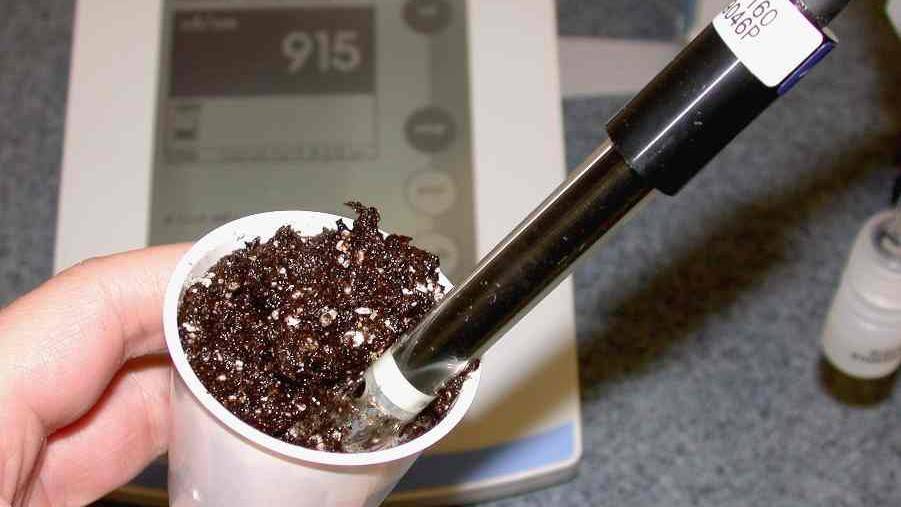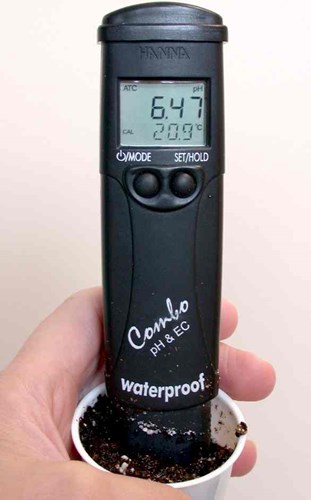Media and Tissue Testing - Measuring pH and E.C. of Media


In part 2 of Media and Tissue Testing, we discussed various types of testing methods used to prepare a growing medium sample for testing. In this article, we will continue the discussion by talking about how to prepare the sample for testing and then how to test the pH and electrical conductivity (E.C.). As we will see, the normal ranges for each test method will vary, so one “normal range” does not apply to all test methods.
Sample Preparation
When preparing a growing medium sample for testing using the saturated media extract (S.M.E.), or the 2:1 or 5:1 (water: growing medium ratio) test method, the sample must sit for at least 45 to 60 minutes before testing. For the pour-through and squeeze methods, the growing medium should be watered to saturation with irrigation water 60 minutes before testing. Once the sample is ready for testing, it should be tested immediately.
The longer the growing medium sample is allowed to sit in a solution, the more limestone will dissolve, further increasing the pH of the sample. This is especially true with an unused growing medium that has its full limestone charge.
Extracting Growing Medium Solution for Testing?
If the pH or E.C. meter used to test the sample has a cup or small reservoir with the electrode in the base of the cup, the water or solution must be extracted from the growing medium sample. This is true for samples prepared using the S.M.E., 2:1 and possibly 5:1 test methods.
To extract the solution, place the growing medium sample in a coffee filter and squeeze it so the solution runs out through the filter. The solution can then be tested for pH and E.C. For the pour-through and squeeze methods, the solution sample extracted from the growing medium is clean enough that it will not require any additional filtration.
If the pH and E.C. meters are pen types or have probes, they can be inserted directly into the “mud” created by the S.M.E., 2:1 and 5:1 test methods. The only concern is that most pH and some E.C. probes have a glass exterior that can be scratched from perlite, pumice and other abrasive aggregates. If this is a concern, then extract the solution from the growing medium as stated.
| Test Method | Test Sample Is... | Solution Extraction Required from Sample? |
|---|---|---|
| S.M.E | Saturated medium, like mud | Yes |
| 2:1 | Watery mud | Yes |
| 5:1 | Mostly solution, with some mud | Maybe |
| Pour-Through | Clear solution | No |
| Squeeze | Cloudy solution | No |

Once the sample is prepared, it is time to measure the pH and E.C. Before using a pH or E.C. meter, make sure they are calibrated. If not, the data generated from these meters will not be accurate and any crop culture adjustments made to correct a problem may compromise the crop.
pH Results
The normal pH range for various crops, as seen in the table below, applies to all growing medium test methods. The only exception is when the growing medium solution is extracted from an S.M.E., 2:1 or 5:1 sample using a vacuum. This extraction process can increase the pH of the solution by 0.2-0.5 pH units.
| Crop | Low pH | Ideal pH | High pH |
|---|---|---|---|
| Calibrachoa, dianthus, diascia, nemesia, pansy, petunias, snapdragon, verbena, vinca | < 5.2 | 5.4-6.2 | >6.4 |
| Ageratum, alyssum, chrysanthemums, most herbs, impatiens, lantana, lobelia, osteospermum, poinsettia, torenia, most vegetables | <5.5 | 5.7-6.2 | >6.5 |
| Geraniums (zonal), lisianthus, marigolds, New Guinea impatiens, pentas | <5.6 | 5.8-6.5 | >6.8 |
E.C. Results
Once the E.C. of a growing medium sample is known, use the correct interpretive ranges for the test method used to prepare the sample (see table below). For example, an E.C. of 3.5 mmhos/cm is normal according to the pour-through test method so no changes would be required for the fertility program.
But if the test method was a 2:1, then the salts in the growing medium would be very high and aggressive leaching would be required to reduce salts. Notice in the following table that for the test methods that use a higher percentage of solution to make the sample, the salts are more diluted and therefore, the E.C. requirements are lower for each indication range:
| E.C. Interpretation of various test methods * | |||||
| 5:1 | 2:1 | SME | Pour-through | Squeeze | Indication |
| 0.0 - 0.12 | 0-0.25 | 0-0.75 | 0-1.0 | 0-1.0 | Very low. Nutrient may not be high enough to sustain active growth |
| 0.13-0.35 | 0.26-0.75 | 0.76-2.0 | 1.0-2.5 | 1.0-2.5 | Low. Suitable for seedlings, bedding plants and salt-sensitive plants. Low for heavy feeders. |
| 0.36-0.65 | 0.76-1.25 | 2.0-3.5 | 2.6-4.5 | 2.6-4.5 | Normal. Standard range for most plants. High for salt-sensitive plants, and seedlings. |
| 0.66-0.89 | 1.26-1.75 | 3.5-5.0 | 4.6-6.5 | 4.6-6.5 | High** Slightly high for heavy feeders. Reduced vigor and growth may result in low to moderate feeders, particularly during hot weather. |
| 0.9-1.10 | 1.76-2.25 | 5.0-6.0 | 6.6-7.8 | 6.6-7.8 | Very high** May result in salt injury from reduced water uptake. Reduced growth is likely. Symptoms include marginal leaf burn and wilting. Leach |
| > 1.10 | >2.25 | >6.0 | >7.9 | >7.9* | Extreme. Most crops will suffer salt injury. Leach. |
Keep in mind that when most companies and universities refer to normal E.C. ranges, it often applies to the S.M.E. test method. Before an E.C. result is used to influence changes in a fertility program, make sure the proper indication ranges are used to interpret the result.